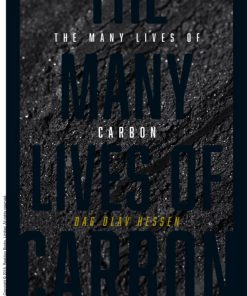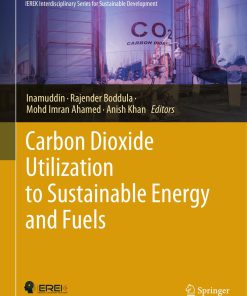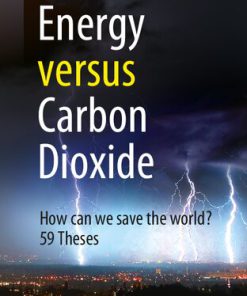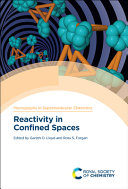Chemical Valorisation of Carbon Dioxide 1st Edition by Georgios Stefanidis, Andrzej Stankiewicz ISBN 9781839164071 1839164077
$50.00 Original price was: $50.00.$25.00Current price is: $25.00.
Chemical Valorisation of Carbon Dioxide 1st Edition by Georgios Stefanidis, Andrzej Stankiewicz – Ebook PDF Instant Download/Delivery: 9781839164071 ,1839164077
Full download Chemical Valorisation of Carbon Dioxide 1st Edition after payment

Product details:
ISBN 10: 1839164077
ISBN 13: 9781839164071
Author: Georgios Stefanidis, Andrzej Stankiewicz
The role of carbon dioxide in our changing climate is now hard to ignore, and many countries are making pledges to reduce or eliminate their carbon output. Chemical valorisation of carbon dioxide, as an alternative to sequestration, is likely to play an important part in reaching these targets, and as such is one of the fastest developing areas of green chemistry and chemical reaction engineering.
Providing a comprehensive panorama of recent advances in the methods and technologies for chemical valorisation of carbon dioxide, this book is essential reading for anyone with an interest in sustainability and green chemistry. Both the technological improvements in traditional processes and new methods and concepts are discussed, including various (renewable) electricity-based methods, as well as novel catalytic, photocatalytic and biocatalytic approaches
Chemical Valorisation of Carbon Dioxide 1st Edition Table of contents:
Chapter 1 – Turning CO2 into Fuels and Chemicals: An Introduction
1.1 Introduction
1.2 Role of CO2 to Chemicals and Fuels Paths in a Future Sustainable Scenario
1.2.1 How to Account for the Impact of CO2 Utilization
1.2.2 Putting CO2 Conversion to Chemicals and Fuels in the Right Scenario
1.2.3 The Cost of CO2 Conversion Technologies
1.3 Paths in CO2 to Chemicals and Fuels Conversion
1.4 Conclusions
List of Abbreviations
Acknowledgements
References
Chapter 2 – Carboxylation with CO2
2.1 Introduction
2.2 Carboxylation of Unsaturated Hydrocarbons via the Addition of Organometallic Species
2.2.1 Alkynes
2.2.2 Alkenes
2.2.3 Dienes
2.3 Oxidative Cyclization
2.3.1 Alkynes
2.3.2 Alkenes
2.3.3 Dienes
2.4 Carboxylation of Organometallic Reagents
2.4.1 Organoboron Compounds
2.4.2 Organozinc Compounds
2.4.3 Other Organometallic Reagents
2.5 Carboxylation of C–X Bonds
2.5.1 Aryl Halides
2.5.2 Alkyl Halides
2.5.3 Allylic Alcohols and Their Derivatives
2.6 Carboxylation of C–H Bonds
2.6.1 Carboxylation of C(sp)–H Bonds
2.6.2 Carboxylation of C(sp2)–H Bonds
2.6.3 Carboxylation of C(sp3)–H Bonds
2.7 Conclusions
References
Chapter 3 – Carbonylation with CO2
3.1 Carbonylation with CO2 to Generate Lactams
3.2 Carbonylation with CO2 to Generate Lactones
3.3 Carbonylation with CO2 to Generate Ketones
3.4 Carbonylation with CO2 to Generate Two Carbon–Heteroatom Bonds
3.5 Mass Transfer of Carbon Dioxide in Carbonylation Reaction
3.6 Conclusion
Acknowledgements
References
Chapter 4 – Modern Urea Synthesis
4.1 Introduction
4.2 Urea
4.2.1 A Comparison of Different Urea Production Technologies
4.3 Sustainable Urea Production by Employing the Theory of Change
4.3.1 A Comparison of Different Sustainable Hydrogen and Ammonia Production Processes
4.4 Conclusions
List of Abbreviations
Acknowledgements
References
Chapter 5 – Homogeneous CO2 Hydrogenation
5.1 Introduction
5.2 Homogeneous Carbon Dioxide Hydrogenation to Formic Acid and Formate
5.2.1 Ruthenium Catalysts
5.2.2 Rhodium Catalysts
5.2.3 Iridium Catalysts
5.2.4 Non-precious Metal Catalysts
5.3 Homogeneous Carbon Dioxide Hydrogenation to Methanol
5.3.1 Ruthenium Catalysts
5.3.2 Other Metal Catalysts
5.3.3 Metal-free Catalysts
5.4 Mechanistic Aspects
5.5 Conclusions
References
Chapter 6 – Homogeneous CO2 Copolymerization and Coupling
6.1 Introduction
6.2 Epoxide Copolymerization with CO2
6.3 Olefin Coupling with CO2
6.4 Conclusions and Outlook
References
Chapter 7 – Heterogeneous CO2 Hydrogenation
7.1 Introduction
7.2 CO2 to Methanol
7.3 CO2 to Dimethyl Ether (DME)
7.4 CO2 to Formic Acid and Formates
7.5 CO2 to Higher Alcohols
7.6 CO2 to Liquid Fuel
7.7 CO2 to Lower Olefins
7.8 CO2 to Aromatics
7.9 Conclusions
Acknowledgements
References
Chapter 8 – CO2 Methanation
8.1 Introduction
8.2 Thermodynamics
8.3 Catalysts
8.4 Mechanisms
8.4.1 Mechanism on Unsupported Catalysts
8.4.2 Mechanism on Supported Catalysts
8.5 Kinetics
8.6 Reactors
8.7 Conclusions
Acknowledgements
References
Chapter 9 – Methane Dry Reforming
9.1 Dry Reforming – Technology Comparison and Economical Potential
9.2 Mechanistic Considerations
9.3 Coking and Sintering as the Main Challenges for Catalyst Materials for Dry Reforming
9.4 Catalyst Design
9.4.1 Prevention of Sintering through Catalyst Design
9.4.1.1 Catalyst Support Materials as a Vital Element in the Prevention of Sintering – Engineering
9.4.1.2 Encapsulated Active Metals – Core Shell Approaches
9.4.1.3 Synthetic Methods to Control Active Metal Dispersion and Particle Size
9.4.1.4 Alloying of Active Metals
9.4.2 Prevention of Coke Formation Through Catalyst Design
9.4.2.1 Supported Platinum Group Metals
9.4.2.2 Redox Active Metals and Support Materials
9.4.2.3 Encapsulated Active Metals/Core–Shell Approaches
9.4.2.4 Methods to Control Active Metal Dispersion and Particle Size
9.5 Conclusions
List of Abbreviations
Acknowledgements
References
Chapter 10 – Gas-phase CO2 Recycling via the Reverse Water–Gas Shift Reaction: A Comprehensive Ove
10.1 Background
10.2 Potential Industrial Applications
10.3 Thermodynamic Analysis
10.4 Mechanism Considerations
10.4.1 The Redox Mechanism
10.4.2 The Associative Mechanism
10.5 Catalyst Design
10.5.1 Non-noble-metal-based Catalysts
10.5.1.1 Ni-based Catalysts
10.5.1.2 Cu-based Catalysts
10.5.1.3 Fe-based Catalysts
10.5.2 Hybrid-metal-oxide Catalysts
10.5.3 Carbide-support Catalysts
10.6 Summary and Outlook
Acknowledgements
References
Chapter 11 – Heterogeneous Copolymerization of CO2
11.1 Introduction
11.1.1 Initial Findings in Copolymerization of CO2 and an Epoxide
11.2 Development of the Zinc Glutarate Systems
11.2.1 Effect of Supports, Templates, and Additives in ZnGA Synthesis
11.2.2 Zinc Adipates and Zinc Pimelates
11.2.3 Terpolymerization Using Zn-dicarboxylate Catalysts
11.2.4 Solid-state Structure and Mechanistic Studies
11.3 Double Metal Cyanide Complexes as Heterogeneous Catalysts
11.4 Summary and Outlook
Acknowledgements
References
Chapter 12 – Artificial Photosynthesis for Production of Solar Fuels and Chemicals
12.1 Introduction
12.2 Natural Photosynthesis as the Blueprint for Artificial Photosynthetic Systems
12.2.1 Molecular Principles of Oxygenic Photosynthesis
12.3 Photoelectrochemical CO2 Reduction
12.3.1 General Principles
12.3.2 Products of Photoelectrochemical CO2 Reduction
12.3.2.1 Carbon Monoxide (CO)
12.3.2.1 Carbon Monoxide (CO)
12.3.2.2 Formate and Formic Acid
12.3.2.3 Methanol
12.3.2.4 Methane
12.3.2.5 Ethanol
12.3.3 Electrocatalytic Conversion Systems with Integrated PV Modules
12.4 Semi-artificial Photosynthetic Systems for Solar-driven CO2 Reduction
12.4.1 Biomolecular (Enzymatic) Solar-to-Fuel Systems
12.4.2 Biohybrid Systems with Microbial Cell Factories
12.5 Future Outlook
Acknowledgements
References
Chapter 13 – Photocatalytic CO2 Reduction Reactions
13.1 Introduction
13.2 Basic Considerations of Photocatalytic CO2 Reduction Reactions
13.2.1 Mechanisms of Photocatalytic CO2 Reduction
13.2.2 Challenges of Photocatalytic CO2 Reduction Reactions
13.2.3 Performance Evaluation of Photocatalytic CO2 Reduction
13.2.3.1 Activity
13.2.3.2 Product Selectivity
13.3 Influence Factors of Photocatalytic CO2 Reduction Performance
13.3.1 The Light-absorption Range and CB Position of Photocatalyst
13.3.2 The Transfer and Separation of Photogenerated Charge Carriers
13.3.3 Surface Catalytic Reaction Rate
13.3.4 Adsorption/Desorption of Reactants/Intermediates
13.3.5 Local Density of the Photogenerated Charge Carriers
13.4 Design Strategies of High-efficiency CO2 Reduction Photocatalyst
13.4.1 Tuning the Band Structure by Impurity Doping
13.4.2 Local Surface Plasmon Resonance (LSPR)
13.4.3 Strategies for Transfer and Separation of Photogenerated Charge Carriers
13.4.4 Surface Vacancies
13.4.5 Single-atom Active Sites
13.4.6 Surface Functional Group Modification
13.5 Conclusions and Perspectives
Acknowledgements
References
Chapter 14 – Plasmonic Photoreactors for Photocatalytic CO2 Conversion
14.1 CO2 Photocatalytic Conversion: From the Promise to the Reality
14.1.1 The Potential of Solar Energy
14.1.2 Thermodynamics: The Limits of Solar Energy Conversion
14.1.3 Concepts for the Integration of Solar Energy in Chemical Processes
14.1.4 Requirements for Industrial Scale Solar Fuels
14.1.5 Basic Elements of Photocatalytic Reactor Design
14.1.5.1 Radiation Model
14.1.5.2 Kinetic Model
14.1.6 The Reactor Boundaries
14.2 Plasmonic Microreactor: A Light Harvesting Device Concept
14.2.1 The Concept
14.2.2 Fabrication
14.2.3 Test
14.3 Plasmonic Materials
14.3.1 Main Materials Used
14.3.2 Main Synthesis Routes
14.3.3 Other Applications of the Plasmonic Materials
14.4 Conclusions and Outlook
Acknowledgements
References
Chapter 15 – Solar-thermal Catalytic CO2 Splitting
15.1 Solar Thermochemical Fuel Production
15.2 CeO2 for CO2 Splitting
15.3 Pure CeO2 for the Solar Thermochemical Splitting of CO2
15.4 Doping of CeO2 for Improved Thermochemical CO2 Production
15.4.1 Doping with Zirconia
15.4.2 Doping with Hafnium and Other Metals
15.5 Conclusions
References
Chapter 16 – Electrochemical CO2 Reduction
16.1 Introduction
16.2 Heterogeneous Catalysts for CO2 Reduction Reaction
16.2.1 Strategy for C1 Selectivity
16.2.1.1 Carbon Monoxide
16.2.1.2 Formic Acid or Formate
16.2.1.3 Formaldehyde
16.2.1.4 Methanol
16.2.1.5 Methane
16.2.2 Strategy for C2/Cn Selectivity
16.2.2.1 Ethylene
16.2.2.2 Ethanol
16.2.2.3 Cn Products
16.3 Homogeneous Catalysts
16.3.1 Introduction
16.3.2 Heterogenized Systems
16.3.3 Reduction of CO2 with Two Electrons
16.3.3.1 Mechanistic Insights
16.3.4 Reduction of CO2 Beyond Two Electrons
16.3.4.1 Formaldehyde
16.3.4.2 Methanol
16.3.4.3 Methane
16.3.5 Reduction of CO2 Coupled to C–C Bond Formation
16.3.5.1 Oxalate
16.3.5.2 Higher Reduction Products
16.4 Frontiers Between Homo-/Heterogeneous Catalysts
16.4.1 Single Atom Catalysts
16.5 Operando Characterization
16.5.1 Infrared Spectroscopy
16.5.2 Raman Spectroscopy
16.5.3 X-ray Absorption Spectroscopy (XAS)
16.5.4 X-ray Photoelectron Spectroscopy (XPS)
16.5.5 Necessity for Labelled Studies
16.5.6 DEMS as a New and Complementary Spectroscopic Method
16.6 Concluding Remarks
References
Chapter 17 – Advances in Electrochemical Carbon Dioxide Reduction Toward Multi-carbon Products
17.1 Introduction
17.2 Molecular Scale: Electrocatalysts, Mechanisms and Electrolyte Effects for CO2RR to Multi-carbon
17.2.1 Copper Based Electrocatalysts
17.2.2 Copper-based Multi-metallic Electrocatalysts
17.2.3 Non-copper Based Electrocatalysts for the Production of Multi-carbon Products
17.2.4 Cascade Electrocatalysis
17.2.5 Electrolyte Effects
17.3 Electrolyser Scale: Cell Designs and Components
17.3.1 Electrochemical H-cells
17.3.2 Gas Diffusion Electrodes
17.3.3 Three-chamber GDE Flow Cells
17.3.4 Membrane Electrode Assembly Cells
17.3.5 Electrolyser Stacks
17.3.6 Promising Results at the Electrolyser Scale
17.4 Process Scale: Integrating the CO2RR to Multi-carbon Products into a Process
17.4.1 Product Selection
17.4.2 Electricity Costs
17.4.3 Product Separation
17.4.4 Integrated Process Design
17.5 Conclusion
Acknowledgements
References
Chapter 18 – Techno-economic Analysis of CO2 Electroreduction
18.1 CO2 Electroreduction Framework
18.2 Modelling and Assessment Methodology
18.2.1 System Boundaries and Carbon Footprint Evaluation
18.2.2 Metrics and Proposed Methods in the Economic Evaluation
18.3 Analysis of Trends in CO2 Conversion by Electrochemical Reduction
18.3.1 Case Study of Formic Acid: Techno-economic Figures for Electrochemical Production
18.3.2Environmental Feasibility of CO2-based Products
18.3.3 Profitability of the CO2 Electroreduction Products
18.4 Remaining Challenges
Appendix
References
Chapter 19 – Microwave-assisted Catalytic Dry Methane Reforming
19.1 Introduction
19.2 Interaction of Microwaves with Solid Catalysts
19.3 Catalyst Development for Microwave-assisted Dry Methane Reforming
19.4 Reactor Design and Scale-up Aspects of Microwave-assisted Dry Methane Reforming
19.5 Alternative Electricity-based Heating Techniques for (Dry) Methane Reforming
19.6 Conclusions
References
Chapter 20 – CO2 Hydrogenation With a Dielectric Barrier Discharge Reactor
20.1 Introduction
20.2 Hydrogenation of CO2 with DBD Reactors
20.2.1 DBD Plasma Reactors
20.2.2 Plasma Hydrogenation of CO2
20.2.3 Gas Phase Reaction Mechanism of Plasma CO2 Hydrogenation
20.3 Plasma-catalytic Hydrogenation of CO2 in a Packed-bed DBD Reactor
20.3.1 Combination of Plasma with Catalysts
20.3.2 Catalyst Material
20.3.3 Mechanism of Plasma-catalytic CO2 Hydrogenation
20.4 Conclusion and Outlook
Acknowledgements
References
Chapter 21 – CO2 Splitting With Nanosecond Pulsed Discharge
21.1 Introduction
21.2 CO2 Dissociation Reactions
21.3 Non-thermal Plasma (NTP) Technologies for CO2 Splitting
21.3.1 Dielectric Barrier Discharge (DBD)
21.3.2 Corona and Spark Discharges
21.3.3 Microwave (MW) and Radio-frequency (RF) Discharges
21.3.4 Gliding Arc Discharge (GAD)
21.3.5 Nanosecond Pulsed Discharge (NPD)
21.4 CO2 Splitting in NPD Driven Reactors: A Thorough Parametric Study
21.4.1 Impact of Specific Energy Input (SEI)
21.4.2 Impact of Pressure
21.4.3 Impact of Interelectrode Gap
21.4.4 Impact of Promoter Gas Addition
21.4.5 Impact of Packing Material
21.5 Plasma Diagnostics
21.6 Plasma Modelling
21.7 Conclusions
References
Chapter 22 – Valorisation of Carbon Dioxide via Enzymatic Transformation
22.1 Introduction
22.2 CO2 Converting Enzymes
22.2.1 Carbonic Anhydrase versus Formate Dehydrogenase Catalysis
22.3 Enzymatic Cascade Conversion of CO2 to Chemicals
22.4 FDH Enzymes
22.4.1 Metal Dependent FDHs: Recent Progress
22.5 Significance of the Electron Donors Supporting FDH Catalysed CO2 Reduction
22.6 Enzyme Robustness
22.7 Conclusions and Perspectives
Acknowledgements
References
Chapter 23 – Microbial CO2 Conversion Routes
23.1 Introduction
23.2 Major Advantages and Challenges
23.3 Main CO2 Fixating Microbes and Related Pathways
23.4 Most Promising Products and Process Configurations
23.5 Strategies to Improve CO2 Conversion Efficiency
23.6 Outlook, Future Prospects and Conclusions
23.6.1 Outlook and Future Prospects
23.6.2 Conclusions
List of Abbreviations
Acknowledgements
References
Chapter 24 – Hydrothermal CO2 Reduction Using Metals and Biomass Derivatives as Reductants
24.1 Hydrothermal CO2 Reduction Processes in Nature
24.2 Hydrothermal CO2 Reduction with Metals as Reductants: an Overview
24.3 Mechanisms and Kinetics of Hydrothermal CO2 Reduction with Metals
24.4 Comparison of Different Carbon Sources
24.5 Hydrothermal Decomposition and Fractionation of Lignocellulosic Biomass Waste
24.6 Screening of Organic Reductants Obtained by Hydrothermal Fractionation of Biomass
24.7 Mechanisms of the Hydrothermal Reduction with Organic Derivatives of Biomass
24.8 A Continuous Flow Reactor for the Hydrothermal Reduction of CO2 with Organic Biomass Derivative
24.9 Conclusions
Acknowledgements
References
Chapter 25 – Life Cycle Analysis of CO2 Valorisation
25.1 Introduction
25.2 Life Cycle Assessment
25.2.1 Definition of the Goal and Scope
25.2.2 Life Cycle Inventory Analysis
25.2.3 Life Cycle Impact Assessment
25.2.4 Interpretation
25.3 Environmental Impacts of CO2 Valorisation
25.3.1 Methane
25.3.2 Methanol
25.3.3 CO
25.3.4 DME
25.3.5 DMC
25.3.6 Polyols
25.3.7 Normalised Results
25.4 Conclusion and Recommendations
Acknowledgements
References
Subject Index
People also search for Chemical Valorisation of Carbon Dioxide 1st Edition:
carbon dioxide valorization
carbon valorization
10 chemical properties of carbon dioxide
chemistry carbon dioxide
2 chemical properties of carbon dioxide
Tags: Georgios Stefanidis, Andrzej Stankiewicz, Chemical Valorisation, Carbon Dioxide
You may also like…
Biology and other natural sciences - Ecology
Uncategorized
Medicine - Surgery
Clinical and Surgical Aspects of Congenital Heart Diseases Text and Study Guide Georgios Tagarakis
Uncategorized
Engineering - Energy & Power Resources
Carbon Dioxide Utilization to Sustainable Energy and Fuels by Inamuddin 9783030728779 3030728773
Engineering
Technique - Nanotechnology











